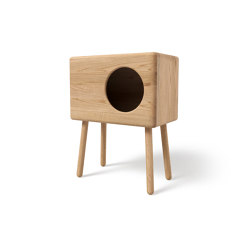moser 1–256
Chairs from horgenglarus
Product description
Hand-woven cane seat, back, legs and seat frame solid bentwood
W42, D49, H80, SH46
W42, D49, H80, SH46
Concept
Stylish, downright delicate and yet robust—moser is the epitome of the Swiss chair. To many Swiss people this simple design classic is the "chair of chairs:" The 1–250 model, or the "Moser chair" as it became soon known amongst architects and in common parlance, has been in the limelight right from the start to become horgenglarus' best-known piece of furniture. It has been pictured in all horgenglarus catalogues published since 1932.
Architect Werner Max Moser first showcased his wooden chair in 1931 at the Neubühl home show in a version with a broad back. After the war the chair continued to be in great demand. It was pictured in 1954 on the title page of the product catalogue published by the Swiss association of workmen, and in 1958 its models "183 M" and "183 MA" received the "Die gute Form" award. Such glory attracts copycats but the archives say, "all the other similar or copied chairs are perceived to be plagiarism."
The Moser chair can be used in a multitude of environments and is very comfortable to sit also for extended periods. Werner Max Moser, a student of Frank Lloyd Wrights, limited his first furniture design to absolute essentials—yet the Moser chair with its round legs and their slight sways creates an air of familiarity. It is reminiscent of the era's bentwood chairs and of the classic horgenglarus chair. There are chairs with similar purism, a comparable level of stability and comfort, but it's the combination which makes the moser unique thanks to its stable seat frame. The quality of the wickerwork is also superior: The robust cane wickerwork is hand-woven into the chair frame and knotted there to give it distinctively more hold than machine wickerwork pressed into a groove. A continuity of proven elements, and they are as modern today as they were then.
Architect Werner Max Moser first showcased his wooden chair in 1931 at the Neubühl home show in a version with a broad back. After the war the chair continued to be in great demand. It was pictured in 1954 on the title page of the product catalogue published by the Swiss association of workmen, and in 1958 its models "183 M" and "183 MA" received the "Die gute Form" award. Such glory attracts copycats but the archives say, "all the other similar or copied chairs are perceived to be plagiarism."
The Moser chair can be used in a multitude of environments and is very comfortable to sit also for extended periods. Werner Max Moser, a student of Frank Lloyd Wrights, limited his first furniture design to absolute essentials—yet the Moser chair with its round legs and their slight sways creates an air of familiarity. It is reminiscent of the era's bentwood chairs and of the classic horgenglarus chair. There are chairs with similar purism, a comparable level of stability and comfort, but it's the combination which makes the moser unique thanks to its stable seat frame. The quality of the wickerwork is also superior: The robust cane wickerwork is hand-woven into the chair frame and knotted there to give it distinctively more hold than machine wickerwork pressed into a groove. A continuity of proven elements, and they are as modern today as they were then.
More about this product
Categorised in Seating - Chairs - without armrests - 4-leg base - open base - Seat woven natural fibre - Seat unpadded - Wood - Base solid wood - Residential - Contract - Office - Conference / Meeting - Hospitality - Places of worship.
Part of the collection
CHAIRS.
Manufacturer
horgenglarus
Family
moser
Architonic ID
1009317
Order number
1–256 HG 203
Year of Launch
1931
Also available in 11 other variants
More products from moser family
Downloads
Related Projects
Contact information
Get more information
Sign in to your Architonic account to have your contact details filled out automatically for each request.
Where to buy this product

More from
horgenglarusContact information
Where to buy this product


